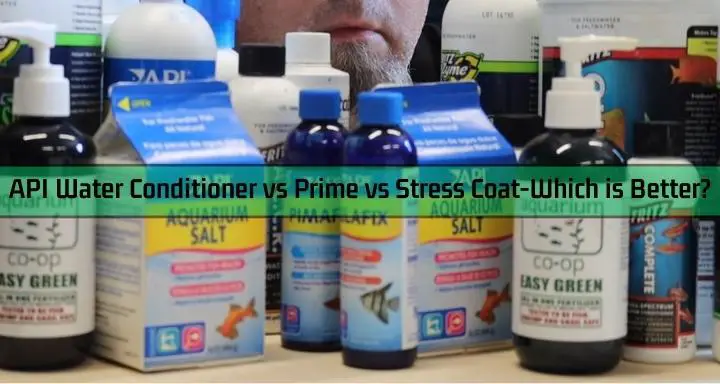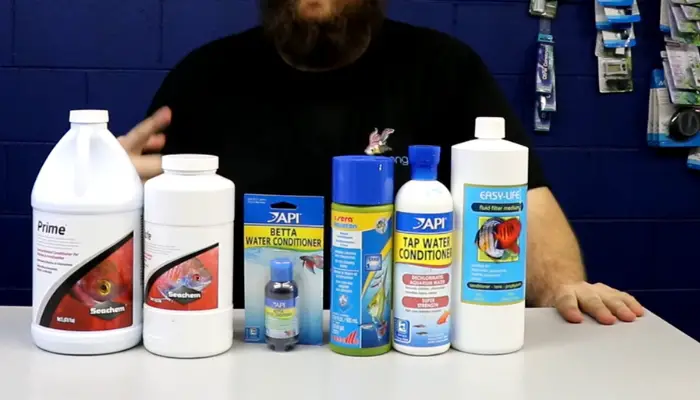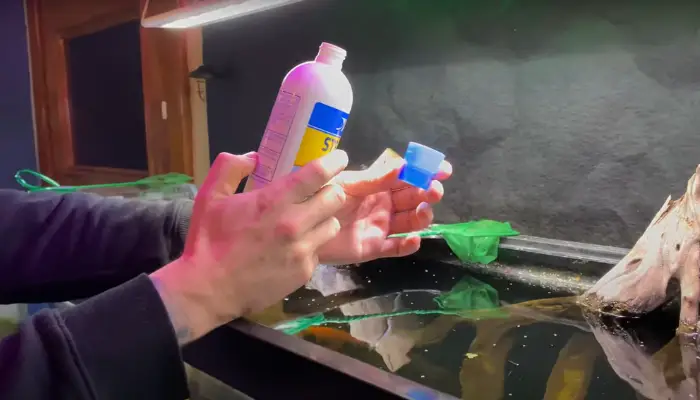
As far as I experienced, API Water Conditioner, Prime, and Stress Coat are all popular products used in the aquarium hobby to treat tap water and provide additional benefits to fish. But sometimes hobbyists become confused among them about which one is the best.
Also, they want to search for their similarities and dissimilarities to find the appropriate one needed for them. Last night, one of my friends was also asking this to me. Then I mentioned some basic points like how they work, how they protect slime coats, and their necessity and amount can create a clear vision of their difference.
Maybe, you are also one of them and that’s why you are here. Trust me, I will try my best not to disappoint you. Check the highlights in the following table and detailed information, therefore.
| Comparison | API conditioners | Prime | Stress coat |
| How they work | Basic conditioner that is helpful to smooth the hard water | Highly concentrated and well for removing high toxication | Having aloe vera which creates soothing conditions for the fish |
| Amount needed | Differs due to the tank size and water condition | Lower than API due to high concentration | Lower than API but higher than prime |
| Slime coat protection | Formation and maintenance of slime coat | Help in the maintenance of slime coat | Artificial slime coat additive can repair and enhance that |
| Necessity | Make the tap water safe for the fish | Easily remove the unwanted toxicants from the aquarium water | Make a soothing environment for all the aquarium inhabitants and best in repairing the damaged parts of the fish |
API Water Conditioner vs Prime vs Stress Coat

How They Work
Here is the first point of understanding which you can differentiate between these three types of aquarium materials. As they differ in ingredients and other processes, their working mode will not match each other.
Firstly, API Water Conditioner removes chlorine and chloramines from tap water, making it safe for aquarium use. It is not highly concentrated like prime or not soothing like a stress coat due to the absence of any extra ingredients. More clearly, it is a basic water conditioner that will help your fish to live smoothly.
On the other hand, Seachem Prime is a highly concentrated conditioner that works by converting harmful substances in tap water into a non-toxic form that can be easily removed through biological filtration or water changes. It is widely used by aquarium hobbyists and professionals to help create a safe and healthy environment for fish and other aquatic organisms.
Lastly, Stress Coat, also produced by API, is a water conditioner that not only removes chlorine and chloramines but also contains aloe vera, which helps to promote the healing of damaged fish tissue and reduce stress. Here, the elegance of this product remains in the aloe vera content which is too helpful for the fish’s health.
Amount Needed
The amount of API water conditioner needed will depend on your water state, the amount of water, and the manufacturer’s instructions. If your aquarium or fish tank is small and the water is not so hard, it will require less. Otherwise, you will have to add a high amount of conditioner.
On the other hand, prime is highly concentrated. That means, though it depends on tank size and water details, you will need a smaller amount of this product compared to other water conditioners.
The third one which is a stress coat will also take the same formula as I described in the case of API and prime. But the amount will be higher than prime but a bit lower than the API water conditioner due to its quality.
Slime Coat Protection

The next differentiating point is the slime coat. A slime coat is a natural layer of mucus that covers a fish’s skin and scales, protecting against parasites, bacteria, and other pathogens. A healthy slime coat is essential for fish to ward off infections and maintain proper osmoregulation.
API Water Conditioner helps in the formation and maintenance of the slime coat, which is a natural protective barrier on the fish’s skin.
Also, prime creates a healthy slime coat for the fish that reduces the risk of infections and supports the fish’s overall health.
Contrarily, a stress coat includes an artificial slime coat additive, which can benefit fish with damaged or compromised slime coats, providing a protective layer against infections and parasites. More clearly, a stress coat helps to reinforce and replace this slime coat, improving the overall health and vitality of the fish.
Also, the stress Coat contains aloe vera and other beneficial compounds that help to enhance and repair the slime coat more than the other two options.
Necessity
Though all these three products are necessary for the aquarium, their necessity may vary due to their capacity. API Water Conditioner is designed to make tap water safe for aquatic animals by removing harmful substances and providing essential elements for fish health.
Surprisingly, certain API water conditioners may also include pH stabilizers to help maintain a stable pH level in the aquarium. These stabilizers can help prevent sudden shifts in pH, which is stressful for fish and it negatively affects their health. Here, the specific ingredients used in pH stabilizers may vary depending on the product.
On the other hand, Seachem Prime is a popular water conditioner used by aquarium enthusiasts to remove chlorine, chloramine and detoxify ammonia, nitrite, and nitrate in tap water. It is commonly used during water changes or when preparing new water for the aquarium.
Contrarily, if fish have wounds or damaged fins, the aloe vera in Stress Coat can aid in the healing process by providing a protective barrier and promoting tissue regeneration. It can also help prevent infection in open wounds helping the fish.
4 Similarities That You Will Find Among API Water Conditioner, Prime, And Stress Coat
1. Dechlorination
In the first step, let’s discuss the dechlorination ability of these three types of aquarium conditioners. As I am going to explain their similarities, I will talk about only the factor as it is the same for all of them.
One of the primary functions of API water conditioners is to neutralize or eliminate harmful substances such as chlorine and chloramine that are commonly found in tap water as these chemicals can be harmful to fish and other aquatic organisms.
These chemicals are added to municipal water supplies to disinfect the water, but they can be harmful to fish. Water conditioners typically contain chemicals, such as sodium thiosulfate, that react with chlorine and chloramine, rendering them harmless. Thus, they complete their dechlorination process almost in the same way.
2. Detoxification
Next, our topic is detoxification. These water conditioners also detoxify heavy metals present in the water. They help in detoxifying heavy metals like copper, lead, and zinc that may be present in tap water, as these metals can be toxic to fish and invertebrates.
Additionally, they also help to neutralize those heavy metals that may be present in tap water. As these metals can be toxic to fish even at low concentrations, they are best to be removed completely instead of only neutralizing. But they complete both the work of neutralizing and removing.
The water conditioners use chelating agents, such as EDTA (ethylenediaminetetraacetic acid), which bind to heavy metals and make them less toxic or form complexes that can be safely removed during water changes. In this way, you can get a perfect environment for your fish.
3. Ammonia Neutralization
Here, you will meet the point of ammonia neutralization at the third point. Ammonia is a toxic substance produced from fish waste and decaying matter which can be removed by some API Water Conditioner variants. By neutralizing ammonia, it helps prevent ammonia poisoning and maintains water quality.
In newly set up aquariums or during the cycling process, toxic substances like ammonia and nitrite can accumulate. Water conditioners often contain compounds like sodium hydroxymethanesulfinate or sodium bisulfite that temporarily convert ammonia and nitrite into less toxic forms, such as ammonium and nitrate. This provides a safer environment for fish while the aquarium establishes a stable nitrogen cycle.
Now, you may ask me how these materials are mixed with the aquarium. Well, let me make you understand. Fish waste, uneaten food, and decaying organic matter in the aquarium produce ammonia. Bacteria in the aquarium’s biological filter convert ammonia into nitrite and then into less harmful nitrate.
Api water conditioner, prime, and stress coat help to detoxify such ammonia, nitrite, and nitrate by converting them into a non-toxic form temporarily. This gives your biological filter also more time to break down these substances into harmless byproducts.
In this case, I want to mention that Prime is well-known for its ability to detoxify ammonia for up to 48 hours, which can be beneficial in emergencies or during cycling a new aquarium. Stress Coat also contains additives that neutralize these chemicals, making tap water safe for fish.
4. Stress Reduction
The final option is the stress reduction capability of these three elements. The synthetic slime coat formed by the conditioners can help reduce stress in fish caused by transportation, handling, or other environmental changes.
These products contain ingredients that help to reduce stress in fish during water changes or when introduced into a new aquarium. This can be beneficial in minimizing the risk of diseases and promoting overall fish health.
At the same time, they provide a sense of security for the fish and can help them adjust to new conditions more easily. On the other hand, a stress coat contains ingredients such as natural soothing herbs or extracts that have more calming properties. These components help to alleviate stress and anxiety in fish, especially when they are adapting to a new environment.
How to Add a Water Conditioner to the Aquarium?
If you are feeling confused that how to add a water conditioner to your aquarium, let me instruct you completely. Adding an API water conditioner to an aquarium is a straightforward process. Here’s the step-by-step guide you may follow.
Gather the Necessary Equipment
First of all, take a water conditioner, a clean bucket or container, and a water test kit.
Prepare the Water
Then, fill the bucket or container with the amount of tap water you plan to use for the aquarium. Make sure the container is clean, free from any unwanted materials, and designated solely for aquarium use.
Measure the Correct Dosage
Look at the instructions on the API water conditioner bottle to determine the appropriate dosage for the volume of water you are treating. It is quite important to follow the manufacturer’s instructions for proper and safe usage of the fish.
Add the Water Conditioner
Then, pour the recommended amount of API water conditioner into the container with the tap water. You have to stir gently to ensure thorough mixing.
Let it Sit
Allow the water conditioner to work for the specified amount of time mentioned in the instructions. This is typically a few minutes to neutralize chlorine, chloramines and detoxify heavy metals in the tap water.
Test the Water
If you have a water test kit, you can test the treated water for parameters such as pH, ammonia, nitrite, and nitrate levels to ensure that they are within the appropriate range for your aquarium.
Add the Conditioned Water to the Aquarium
Finally, it is time to add a conditioner. After the water conditioner has been given sufficient time to work, slowly add the treated water to your aquarium. You can use a clean bucket, a siphon, or any suitable method to introduce the water while minimizing disturbance to the tank’s inhabitants.
Monitor the Aquarium
This is the observation phase. You have to keep an eye on the water parameters over the next few days to ensure they remain stable and within the desired range. Regular water testing is beneficial for maintaining a healthy aquatic environment.
Which One is the Best?
Meanwhile, I have shown you the comparison between API Water Conditioner, Prime, and Stress Coat depending on several factors, including their specific features, effectiveness, slime coat protection, and compatibility with different aquarium setups.
But if you ask me to choose one of them, I can suggest some factors, not any name as this will vary from person to person according to their usefulness. Let’s have a glance at those facts by which you can choose the best for you.
Water Conditioner Function
All three products serve as water conditioners, which remove chlorine, chloramine and detoxify heavy metals from tap water. You should notice them and consider the effectiveness of each product in neutralizing these harmful substances.
Ammonia and Nitrite Detoxification
If you have concerns about ammonia and nitrite levels in your aquarium, Prime is known for its ability to detoxify these compounds, making it a preferred choice for tanks experiencing high ammonia or nitrite levels than the others.
Stress Reduction and Slime Coat Protection
Stress Coat, as the name suggests, is formulated to reduce stress in fish and promote the healing of damaged skin and fins. Due to the presence of aloe vera, it can provide soothing properties for fish. If you have stressed or injured fish, a Stress Coat might be a better option for you.
Compatibility with Invertebrates
In the case of having invertebrates such as shrimp or snails in your aquarium, it’s important to consider the compatibility of the water conditioner with them. Some water conditioners, including Prime, are considered safe for invertebrates, while others may have specific warnings or precautions.
Concentration and Dosage
Check the concentration of the product and the recommended dosage for your tank size. Consider the cost-effectiveness and how long each product will last based on the dosage required.
Personal Preference
Ultimately, personal experiences and preferences can play a role in determining which water conditioner is better for you. You may want to consider reading reviews or asking for recommendations from fellow aquarists to gain insights into their experiences with these products.
It’s important to note that all of these products have been widely used and have positive reputations in the aquarium hobby. However, different aquariums have unique requirements, so what works best for one person may not necessarily be the same for another.
That’s why, it’s recommended to evaluate these factors carefully and choose the water conditioner that best suits your specific needs and the requirements of your aquarium.
FAQs
Where Can I Purchase These Water Conditioners?
Luckily, they are widely available at pet stores, aquarium supply stores, and online retailers. You can check with your local pet store or search online to find a supplier that offers these products and may get one of your choices.
Can these water conditioners be used in saltwater aquariums?
Surely, you can. All of them can be used in both freshwater and saltwater aquariums. They are suitable for treating tap water, removing chlorine and chloramines, and detoxifying ammonia and nitrites, regardless of the type of aquarium setup.
Can These Water Conditioners Be Used With Other Aquarium Medications?
Yeah, obviously, in general, these water conditioners can be used to assist with other aquarium medications. However, I always recommend reading the instructions of both the water conditioner and the medication you intend to use to ensure compatibility as some of them have specific instructions or precautions regarding the use of water conditioners.
Final Words
However, let me conclude here the detailed information about API water conditioner vs prime vs stress coat. Guys, I tried to present it simply so that you can easily differentiate them as I learned when I first started keeping an aquarium. Just point to their activities and you can measure the difference. Still, if you have any questions, you can follow me.
I have also included some other facts about conditioner use in aquariums on my website. You can check those if you need extra information. Else, I can provide you with more informative writing according to your preferences, and feel free to notify me about that.
- Top 15 Freshwater Aquarium Plant Ideas for a Lush, Green Tank - November 9, 2024
- Top 13 Freshwater Aquarium Layout Ideas for a Beautifully Organized Tank - November 9, 2024
- 14 Stunning Rustic Freshwater Aquarium Ideas for a Tranquil Environment - November 9, 2024
